#prehistoric Poland
Text

#Andrzej Pityński#światowid#grounds for sculpture#new jeresy#slavic gods#slavic#polish pagan polytheism#polish gods#polish art#pagan gods#Pagan Poland#prehistoric Poland#polish pagan god#Slavic pagan god#sculpture#Hamilton township#mine
1 note
·
View note
Photo




polish roundels (aka circular neolithic enclosure in Central Europe)
Drzemlikowice, Oława, Tylice, Nowe Objezierze
#neolithic#prehistory#stone age#archaeology#prehistoric europe#rondels#roundels#neolithic circular enclosures in central europe#stroked pottery culture#lengyel culture#earthworks#central europe#poland#archeology#my upl
102 notes
·
View notes
Text
Osmolskina czatkowicensis

Small kiełbasa found in Poland. Smaller than euparkeria this lil brzęczyszczykiewicz hunter a oldest tail-less frog yet found named czatkobatrachus
#art#drawing#mesozoic#paleoart#paleontology#dinosaur#palaeoblr#paleomedia#prehistoric#science#paleoblr#paleozoic#poland
30 notes
·
View notes
Text
Archaeologists chance upon a 7,000-year-old impeccably preserved skeleton in Poland.
25 notes
·
View notes
Text

Stagonolepis
Stagonolepis — вимерлий рід стагонолепідних етозаврів, відомий з пізньотріасової (карній) формації Хассберге в Німеччині, Дравоських відкладів у Польщі та Лосімутських пісковиків у Шотландії. Імовірні скам’янілості з Північної та Південної Америки були віднесені до власних родів Calyptosuchus та Aetosauroides відповідно.
Повний текст на сайті "Вимерлий світ":
https://extinctworld.in.ua/stagonolepis/
#stagonolepis#aetosaur#triassic#dinosaurs#scotland#poland#germany#paleontology#paleoart#prehistoric#палеоарт#палеонтологія#ukraine#ukrainian#animals#digital art#fossils#extinct#ua#article#illustration#україна#мова#динозавр#німеччина#польща#арт#українцівтамблері
19 notes
·
View notes
Text

BALTIC-PONTIC STUDIES
Vol 25 - 2021
Globular Amphora Culture, Central and Eastern Groups: insight into new
chronometric and taxonomic data
Sinopse:
O vigésimo quinto volume dos Estudos Báltico-Pônticos reúne estudos adicionais – após os volumes nos. 4 e 8 – dedicados à cultura da Ânfora Globular. Sítios associados a esta unidade são encontrados nas vastas extensões da Europa Central e Oriental, desde a bacia do Reno, a oeste, até o rio Dnieper, a leste. Por sua vez, o seu impacto é identificado de forma ainda mais ampla – desde o Mar Báltico ao Mar Negro e ao Mar de Azov. No entanto, ao longo da vida dos grupos humanos relacionados à unidade em questão, seu coração localizou-se nas terras baixas da Europa Central. ...
segue lendo em: https://archaeoethnologica.blogspot.com/2023/02/baltic-pontic-studies-vol-25.html
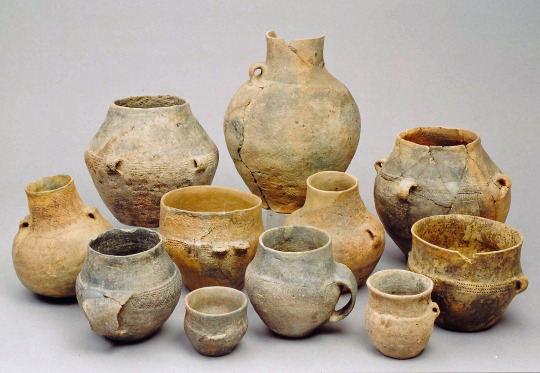
#archaeology#Globular Amphora Culture#Yamnaya culture#East European Archaeology#Ucraine#Poland#Central Europe#Central European Archaeology#Prehistory#Neolithic#Calcolithic#Prehistoric Archaeology#European Archaeology#Prehistoric European Archaeology#Cultural Conctats#Archaeological Cultures
0 notes
Text
It was around 5 pm on March 15, and the light was fading fast, when Constantin and Tatiana were attacked by the bear. The young couple, aged 29 and 31 and identified in local media reports only by their first names, were Belarusians living in Poland. But Constantin had been working for the winter as a ski instructor in Jasná, a popular resort in neighboring Slovakia. The winter season was coming to an end, and on a day off he’d decided to go hiking with his girlfriend beneath the 4,718 foot-high peak of Na Jame, in the Slovak national park surrounding the resort.
What happened next is not exactly clear, but newspaper reports suggest that when the couple encountered the bear—a young male weighing about 265 pounds—they ran in different directions. Finding himself alone, Constantin tried calling Tatiana. When he failed to get a response, he called mountain rescue. It was dark when they eventually found Tatiana’s body, with the help of a search dog. She’d apparently fallen down a ravine, sustaining fatal injuries to her head.
As with previous bear-related fatalities, both in Slovakia and across Europe, the incident has sparked accusations that conservationists are protecting bears at the expense of people’s safety. In 2021, a 57-year-old man was killed by a bear in the same national park, stoking community tensions about their presence and leading to calls for a cull. As it stands, however, hunting the animals is banned under both Slovakian and European law, and experts argue vociferously that a lack of education—rather than a focus on conservation—is the primary cause of the problem.
“It’s really kicked off here, with the press and politicians I think making some unjustified statements,” says British-born zoologist Robin Rigg. A specialist in large carnivores, Rigg is the chair of the Slovak Wildlife Society, which he set up in 1998, two years after moving to the country. Initial reports suggested that Tatiana might have been killed by the bear itself rather than by her fall, Rigg explains. “And it’s been said in public—actually by someone from the Ministry of the Environment—that it was a predatory attack. But I don’t see the evidence for that.”
Although the animal was near the body when rescuers found Tatiana, “that doesn’t mean the bear was intending to kill and consume her,” Rigg says. He stresses that he hasn’t seen all the evidence, so any conclusions are provisional. But he has seen some of the grisly photos that were leaked to the media, “and none of them show signs of consumption.” Puncture marks found in the young woman’s leg, he says, “look like claw marks—they’re not signs of feeding.”
“It's extremely rare in Europe to have predatory attacks, and it’s not a common thing anywhere in the world,” Riggs says. This incident occurred in an area where bears are known to hibernate, at a time of year when they are just waking up. “And what can sometimes happen is that the bear reacts aggressively in defending itself, which is what I think is most likely to have happened in this case—that it was startled by these two people appearing,” Rigg says.
Unfortunately, this kind of nuance doesn’t often feature in coverage of bear attacks. “You’re actually more likely, statistically, to get hit by lightning or have an allergic reaction to a bee sting,” Rigg says, “but people don’t worry as much about that as they do about a big animal with sharp teeth and claws. It goes back to an instinctive fear that’s been with us since prehistoric times.”
The argument that Slovakia’s bears are nothing to be afraid of was further undermined when footage emerged of an animal galloping down a main street in Liptovský Mikuláš just two days after Tatiana’s death. The animal was filmed lunging aggressively at pedestrians, who jumped over fences to escape. No one was seriously hurt, but the video went viral. “And now,” Rigg says, “we’ve had these two incidents within 48 hours of each other, within a few kilometers of each other. So the tendency is to look at them together and ask, ‘What should we do about bears?’”
It’s a question that’s become increasingly pressing in recent years—not just in Slovakia but throughout Europe. Having been hunted to the point of extinction in many countries, brown bears had their “strictly protected” status enshrined in EU law in 1992. In most areas where they’re present, bear populations are increasing, and there are now an estimated 17,000 brown bears living in rural areas across the continent. The recovery of this keystone species has been celebrated as a huge win by biologists and biodiversity experts—but it’s not been without its problems.
In the Pyrenees, the mountains that straddle the border between France and Spain, French and Spanish farmers’ unions, sick of dealing with damage to crops, beehives, and livestock, have called for bear numbers to be cut. In the northern Italian province of Trentino, where bears were reintroduced as part of an EU-funded rewilding project, the tragic death of trail runner Andrea Papi in April 2023 brought simmering resentments bubbling up to the surface. To the horror of local scientists, Trentino’s right-wing populist president, Maurizio Fugatti, proposed killing half of the carefully nurtured population of around 120 bears overnight.
Yet, experts say, culling bears is far from the best way to prevent future tragedies. In the wake of Andrea Papi’s death, the local natural history museum invited Tom Smith, a bear management specialist from Utah’s Brigham Young University, to give a talk about how such issues are dealt with in North America. In a sign of how high community tensions were running, the museum took the unusual step of posting an armed guard at the entrance.
In his talk, Smith suggested that the solutions were relatively simple: “What you have here isn’t necessarily a bear problem, it’s a people problem,” he said. Unlike in North America, where people in bear areas have grown up with the animals, Europeans living near recently recovered populations don’t necessarily know how to behave. But with some basic bear-awareness training—of the kind that’s taught “in kindergarten” in some Canadian provinces—the number of dangerous or fatal encounters could be vastly reduced.
Smith runs the North American Human-Bear Conflict Database, which contains detailed information on 2,175 historic attacks, with “a quarter-million data points.” “What I’ve learned by studying these events,” he told the crowd, “is that 60 percent of them were totally unnecessary—and could have been avoided if people had behaved differently.” In an interview a few days later, Smith talked specifically about Papi’s death, telling WIRED, “I can go through the details and say, ‘You should never do that, or that, or that,’ and it’s not victim blaming, it’s trying to say, look, this was fully preventable.”
Tragically, this also appears to have been the case in Slovakia. “Unfortunately, the route that they chose was a very risky one,” Rigg says. “It’s not a recognized hiking route, and it’s a part of the park that’s strictly protected, so they shouldn’t have been there. Added to that, it’s a limestone area, and that’s an area I’d expect there would be denning bears.” The encounter happened around dusk, when crepuscular creatures like brown bears tend to be more active.
And by running away from the animal—particularly by running away in different directions—the couple inadvertently made the situation a whole lot worse. “It would have been better if they’d stayed together and tried to stay calm if possible,” Rigg says, because bears almost never attack people in groups. In the entire North American Human-Bear Conflict Database, Tom Smith said, there’s not “a single case where two people stood their ground and the bear attacked.”
While the human tragedy of Constantin and Tatiana made headlines, the incident may prove damaging to bears too, affecting conservation efforts across Europe. Slovakia’s government (which, like Trentino’s, is right-wing populist) has called for the EU to strip bears of their “strictly protected” status. Adalbert Jahnz, a European Commission environment spokesperson, said he couldn’t comment on these specific calls.
But the decision in December to downgrade wolves from “strictly protected” to “protected,” a status that would allow hunting, has biologists and biodiversity experts worried. “It’s partly political posturing,” says Rigg of the Slovak government’s recent statements, “but I think they really want to try to make that happen—and they probably feel that there’s a bit of an open door now because of what happened with the wolf recently.”
8 notes
·
View notes
Text
Smok Wawelski (Archosaur)
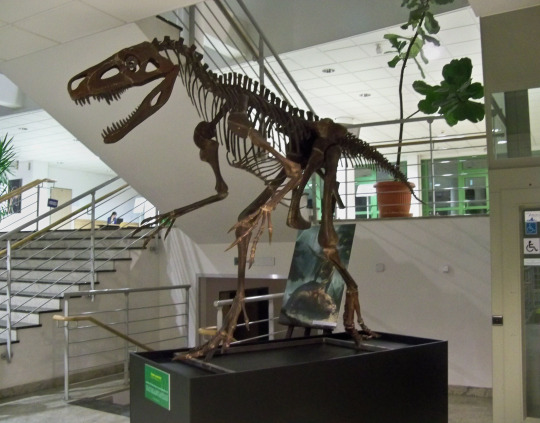
This guy right here is called “Smok Wawelski”, named after a dragon in a popular polish legend (the name translates to “Dragon of Wawel”). It lived during Late Trassic on the territory of, what is now, Poland (more specifically a village called Lisowice). He’s estimated to be around 5 or 6 meters (aka 16 or 20 feet) in length, its skull is 50-60 centemeters long (20-24 inches).

Smok lived alongside a synapsid called Lisowicia (named after the village). It was most likely hunted down pretty frequently by Smok. Here’s a picture of it below.
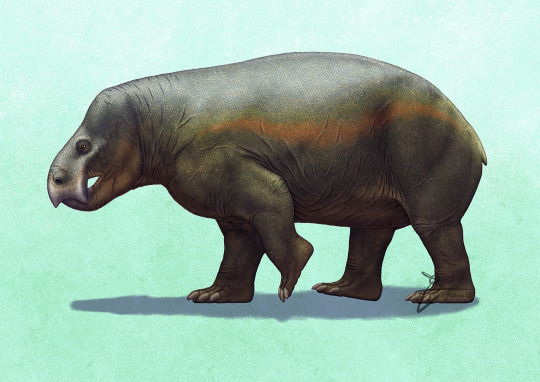
What’s interesting about Smok is that nobody really knows what type of archosaur it is. It could be a rauisuchid, prestosuchid, an ornithosuchid pseudosuchian or a theropod dinosaur. Here are some reconstructions.
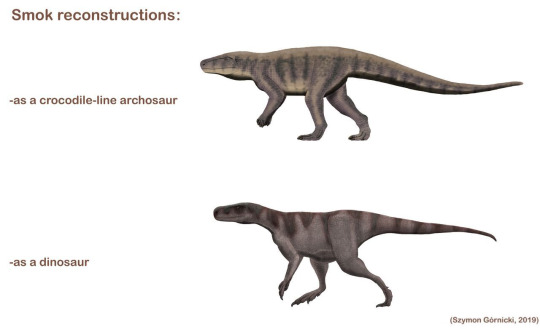
Smok’s one of my favorite prehistoric creatures so I figured I’d make a post about it :) I still don’t really understand how to use tumblr properly but this seems fun.
99 notes
·
View notes
Text
sighing longingly but i'm just thinking about fossilised bamboo pollen and leaves from the neogene found in poland and imagining prehistoric european bamboo forests
6 notes
·
View notes
Text

Polish Women Artists Archives | House of Nuremberg in Cracow Dom Norymberski w Krakowie | The Womenal #Poland | 2019
https://facebook.com/events/s/wystawa-femina%C5%82/450834802194681/
The exhibition titled The Womenal derived from Günter Grass’s novel called The Flounder. Its leading theme is the feminist history of the world according to Grass, the relation between men and women, as well as the criticism of patriarchy and male dominance.
Artists / Artystki: Agata Agatowska, Iwona Demko, Georgia Fambris, Urszula Kluz-Knopek, Natalia Kopytko, Katarzyna Kukuła, Ewa Kulka, Jasmin Lothert, Małgorzata Markiewicz, Agata Norek, Anna Orbaczewska, Elena Provata, Ulrika Segerberg, Małgorzata Wielek-Mandrela
+ Günter Grass
Curators / Kuratorki: Iwona Demko, Renata Kopyto, Marta Wróblewska
House of Nuremberg in Cracow, ul. Skałeczna 2,
Opening: 11.10.2019 at 7 pm.
The exhibition entitled The Womenal derived from Günter Grass’s novel called The Flounder. Its leading theme is the feminist history of the world according to Grass, the relation between men and women, as well as the criticism of patriarchy and male dominance.
The Flounder by Günter Grass was published in Germany in 1977, almost 10 years after social transformations which took place in 1968, during which the second wave of feminism went through West Germany. This book fitted into the atmosphere which was in the air in those times. And despite the harsh criticism it received from the contemporary feminist milieus, from today’s perspective it can be seen as prophetic.
The starting point for this tale about the history of mankind as the history of male emancipation from the power of matriarchy, is the well-known brothers Grimm story which in Polish version is entitled About the Fisherman and Golden Fish, and in German - About the Fisherman and His Wife. In the book two versions are interwoven: in the first one, the caught fish (Grass’s flounder in this case) makes all dreams of the greedy fisherman’s wife come true; in the second one, it is the man who keeps wanting more and more things and power to help him rule the world. Certainly, it leads to a catastrophe and final disaster.
The circle of history described by the author encompasses the primeval tribes from the matriarchy epoch, through the middle ages, after that renaissance, followed by Prussian State, up till contemporary times, that is the 70s of 20th century. Exactly then, three feminists catch the speaking flounder in the North Sea. The fish becomes the personification of the whole male-kind and tells a story how it inspired men to break free from the power of women. He appoints himself the director of the story of humankind and the author of the script for this narration. The book is divided into nine chapters parallel to nine months of pregnancy. The story that is being told is at the same time the interrogation of the big fish in front of a feminist tribunal, the so calledThe Womenal. The emancipation of the male-kind is at the same time the story of women’s subjugation and exclusion from active life. We can trace how they are deprived of the influence on their own lives, and how they are gradually undergoing the oppressive rules of functioning in the patriarchal society.
One of the places they were assigned, apart from bedroom and church, was the kitchen. Grass sees in cooking and perfecting this skill by introducing new ingredients and creating new dishes, a kind of magic, curing witchcraft, the power to control the strength and weakness of the body. Nine women cooks are the protagonists of the novel. They are, according to Grass, an integral part of the local history of Pomerania, and perhaps the global history too. In the prehistoric times women were born with the third breast to feed the men with their own milk, as this ritual had a sedative effect on them. Later on, thanks to introducing potato to the menu, women protected many people from famine, and with the help of warm thick soup they would disarm the tyrants. Enemies were eliminated by adding poisonous ingredients taken from the natural resources and included in the dishes. The Flounder contains numerous recipes and shows their evolution: from milk dishes, through meat and fish diet, up to the discovery of forest fruits and plant cuisine.
If women did not consider marriage as the biggest happiness in their lives, they could go to the nunnery. It was the place where they could finally renounce the sexual services like Dorothea of Montau who, according to Grass “was the first woman (in our region) to rebel against the patriarchal tyranny of medieval marriage” (The Founder, p. 166). Or, on opposite, they could enjoy full sexual freedom like Margarete Rusch. The promiscuous Abbess of Saint Bridget’s Convent “solved the bitterly earnest question of the century, the question of how to serve up the bread and wine, the Lord’s Supper, in her own way, to wit, bedwise, by acrobatically moving her twat into the vertical and offering is as a chalice, which was then filled with red wine” (The Flounder, p. 209).
Despite the considerable understanding for the political and social situation in Germany in the 70s, and the effort to understand and describe the situation of women with empathy, Grass’s novel contains fragments which were unacceptable for the feminist movements, nor for any women working in arts. Professor Maria Janion points out some of the controversial theses uttered by the Flounder, that “only men are equipped with the ability to experience metaphysical feelings”, “making art is only the male domain”, “woman with her ‘moist warmth’ can be at best the source of creative inspiration for men, his silent muse”, “woman should remain unmoved like the ‘mossy earth’ and be happy she can serve.”
Women, who have been able to study and make art at the academies only for the last 100 years, 40 years after The Flounder has been written are able to prove how Grass’s fish was wrong. Among the themes undertaken within the exhibition. The Flounder himself, held responsible for this state of affairs, and put to court, thus announces prophetically: “I gave you the knowledge and power, but all you wanted was war and misery. Nature was entrusted to you, and what did you do, you despoiled it (…). In short: you men are finished” (The Flounder, p. 453). From today’s point of view one can add: also within the domains which the author is willing to defend in the above quotes. One thing is certain though: in this exhibition art is the domain of women. Renata Kopyto
🇵🇱 Tematem wystawy Feminał są wątki z powieści Güntera Grassa pt.: Turbot: feministyczna historia świata według Grassa, jego postrzeganie kobiet i ich relacji z mężczyznami, ale też krytyka patriarchatu i męskiej dominacji. Pierwsza odsłona ekspozycji miała miejsce w Gdańskiej Galerii Güntera Grassa, od 27.04 do 22.06.2019.
Turbot Güntera Grassa ukazał się w Niemczech w 1977 roku, prawie 10 lat po przemianach społecznych, jakie miały miejsce w roku 1968, podczas których przez zachodnioniemiecką republikę przetoczyła się druga fala feminizmu. Książka noblisty wpisywała się w atmosferę, jaka wtedy panowała. I chociaż ówczesne środowiska feministyczne mocno ją skrytykowały, z dzisiejszej perspektywy można tę powieść uznać za proroczą.
Punktem wyjścia do opowieści o dziejach ludzkości jako historii męskiej emancypacji spod władzy matriarchatu jest doskonale znana baśń braci Grimm nosząca w polskiej wersji tytuł O rybaku i złotej rybce, a w niemieckiej O rybaku i jego żonie. W książce pojawiają się jej dwa warianty: w pierwszym wyłowiona ryba, którą u Grassa jest właśnie tytułowy turbot, spełnia wszystkie zachcianki zachłannej żony rybaka, w drugim to mężczyzna jest tym, który ciągle pożąda nowych rzeczy i władzy pozwalającej mu zapanować nad światem. Prowadzi to rzecz jasna do katastrofy i ostatecznej zagłady.
Koło historii, które autor kreśli w powieści, obejmuje pierwotne społeczności epoki matriarchatu, następnie średniowiecze, potem przechodzi do renesansu, dalej z kolei do państwa pruskiego, aż wreszcie do czasów mu współczesnych, czyli lat 70. XX wieku. Wtedy to właśnie trzy feministki wyławiają z Morza Północnego turbota mówiącego ludzkim głosem, który staje się personifikacją całego męskiego rodzaju i opowiada, jak to z jego inspiracji mężczyznom udało się wyzwolić spod władzy kobiet. To on mianuje się reżyserem ludzkich dziejów i autorem scenariusza tej narracji. Zostaje ona podzielona na dziewięć rozdziałów odpowiadającym dziewięciu miesiącom ciąży. Snuta opowieść to jednocześnie przesłuchanie wielkiej ryby przed feministycznym trybunałem, zwanym w powieści Feminałem. Ta emancypacja męskiego gatunku jest także symultaniczną historią zniewolenia kobiet i procesu wykluczania ich z aktywnego życia. Możemy prześledzić jak pozbawia się ich wpływu na własne losy i jak stopniowo poddawane są opresyjnym zasadom funkcjonowania w patriarchalnym społeczeństwie.
Jednym z miejsc, które kobietom wyznaczono, obok sypialni i kościoła, była kuchnia. U Grassa gotowanie, doskonalenie tej sztuki poprzez wprowadzanie nowych produktów i przypraw oraz poprzez kreowanie nowych dań ma urok czarów, znachorstwa, mocy panowania nad ciałem, jego siłą i słabością. Dziewięć kucharek przewijających się przez karty powieści zapisało się na zawsze, według gdańskiego pisarza, w dziejach Pomorza, a może i całego świata. W czasach prehistorycznych wyposażone w trzecią pierś, karmiły własnym mlekiem mężczyzn, na których rytuał ten działał jak środek uspokajający, później dzięki wprowadzeniu do jadłospisu ziemniaka, uchroniły wielu ludzi od klęski głodu, a za pomocą ciepłej i pożywnej zupy rozbrajały tyranów. Wrogów eliminowały zaś wykorzystując umiejętności przyprawiania dań darami natury o śmiertelnym działaniu. W Turbocie znaleźć można sporo kulinarnych przepisów i prześledzić jak one ewoluowały: od potraw mlecznych poprzez mięsne i rybne, aż do odkrywania owoców lasu i kuchni roślinnej.
Jeśli kobiety nie uznawały małżeństwa za swoje największe szczęście, mogły udać się do klasztoru. Było to miejsce, gdzie wreszcie mogły odmówić usług seksualnych jak Dorota z Mątowów, która według relacji Grassa - „była (w naszym regionie) pierwszą kobietą, która zbuntowała się przeciwko patriarchalnemu przymusowi małżeństwa” (Turbot, s. 173), albo wręcz przeciwnie, korzystać z pełnej obyczajowej swobody, jak Margareta Rusch. Powieściowa przeorysza klasztoru św. Brygidy „śmiertelnie poważną kwestię sporną swego stulecia, jak należy podawać chleb i wino, komunię, rozstrzygnęła na swój, a więc łóżkowy sposób, ekwilibrystycznie ustawiając swą cipkę pionowo i oferując jako kielich, do którego się nalewało” (Turbot, s. 214).
Mimo ogromnego wyczucia sytuacji polityczno-społecznej w Niemczech lat 70. oraz próby zrozumienia i opisania z empatią sytuacji kobiet na przestrzeni wieków, w opowieści Grassa pojawiają się pasaże, które były i są nie do przyjęcia ani dla ruchów feministycznych, ani dla jakiejkolwiek kobiety działającej twórczo. Pisze o tym w swojej przedmowie do książki Maria Janion, wymieniając niektóre przekonania głoszone przez turbota: „…tylko mężczyźni wyposażeni są w zdolność do uczuć metafizycznych” lub „Uprawianie sztuki to domena mężczyzn, twórczość artystyczna jest wyłącznie męskim zajęciem. (…) Kobieta wraz z jej <<wilgotnym ciepłem>> może być w najlepszym wypadku źródłem twórczości mężczyzny. Właśnie jego milczącą muzą. (…) Kobieta powinna trwać w bezruchu jako <<mszysta gleba>> i cieszyć się, że służy”.
Kobiety, którym dopiero od 100 lat dane jest studiować na artystycznych uczelniach i uprawiać sztukę, 40 lat po napisaniu powieści mogą pokazać jak bardzo grassowski turbot się mylił. Odpowiedzialny za ten stan rzeczy i postawiony przed sądem ogłasza proroczo: „Dałem wam wiedzę i władzę lecz wy mieliście tylko wojny na myśli. Powierzyłem Wam naturę, a wy zbrukaliście ją. (…) Męska sprawa wykończyła sama siebie” (Turbot, 443). Z dzisiejszego punktu widzenia można dodać: także w dziedzinach, których autor powieści próbuje bronić w przytoczonych powyżej cytatach. Na tej wystawie uprawianie sztuki jest z pewnością domeną kobiet. Renata Kopyto
#ArchiwumSztukiKobiet #PolishWomenArtists #womensart #polishart #sztukakobiet #palianshow
2 notes
·
View notes
Photo

Barvice dolmen
The Barvice Dolmen is a prehistoric burial site located in the village of Barwice in northern Poland.
Read more at: https://paganplaces.com/places/barvice-dolmen/
2 notes
·
View notes
Text
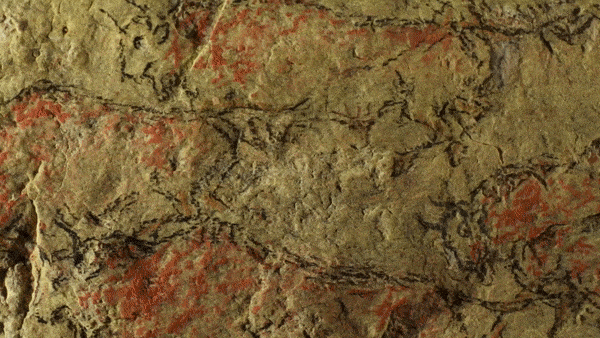
Signum
directed by Witold Giersz
Poland, 2015
A particularly interesting work by the nonagenarian animator, invoking prehistorical cave paintings and the titular signs people leave behind them on natural and man-made walls.
The mixed media film's most notable technique is drawing in pastel directly on slabs of stone. Giersz finds inspiration in the shapes of the rock as he erases and redraws the pose after each frame. The final frame of each shot remains painted on the rock, a movement frozen in time much like the original cave paintings that inspired the film:

6 notes
·
View notes
Photo

cist grave from Tuczno in Kujavia, transported and reconstructed on a courtyard of the Mielżyńscy’s Museum in Poznań, 1917
#neolithic#grave#burial#archaeology#prehistory#stone age#prehistoric europe#poland#museum#archivalia#1917#poznań#megalithic grave#that's what is considered *megalithic* by polish standards#not much good quality stone here#but lots of wood and forests#globular amphora culture#or at least i suppose it is it...#my upl
1 note
·
View note
Text
Borkowice fossil trcakways
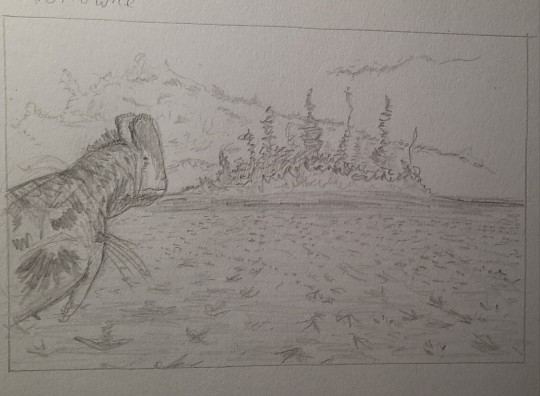
Early Jurassic ~182 million years ago, in what is now the village of Borkowice in Poland, there large 6-meter-long relative of Dilophosaurus walked in muds of drained sea, he and hundreds of other dinosaurs left their tracks in these wetlands without consciously leaving a trace in time, so today we can see them and imagine what happened there and then
#art#drawing#mesozoic#paleoart#paleontology#dinosaur#palaeoblr#paleomedia#prehistoric#science#dilophosaurus#triassic#jurassic period#jurassic#dinosaurs#poland#fossil#speculative fiction#saurian#sketch#sciart#speculative biology
34 notes
·
View notes
Photo
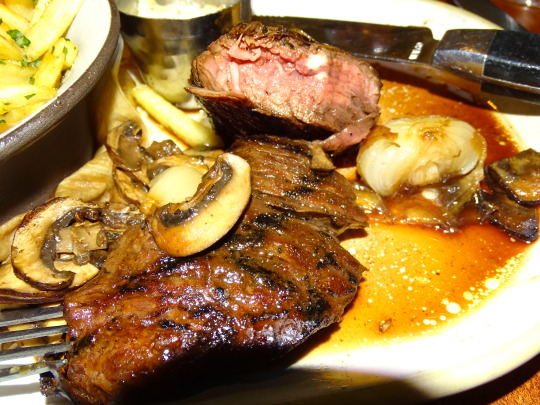


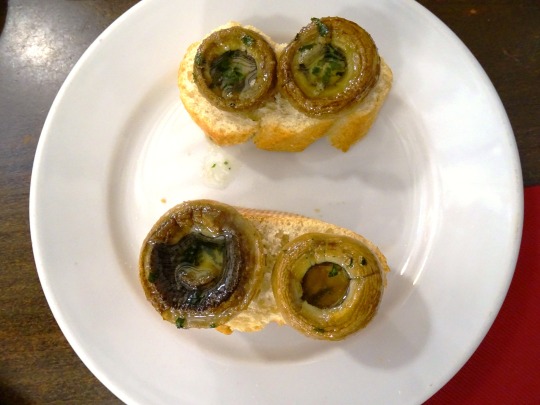




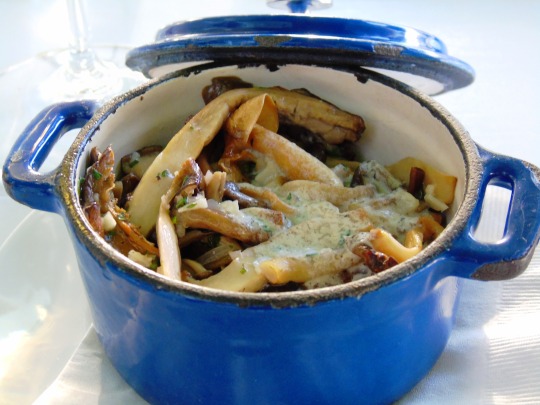

Day of the Mushroom
The Day of the Mushroom celebration is celebrated on April 16 and honors all things fungi. The fleshy, spore-bearing fruiting body of a fungus, which can grow anywhere above ground, on soil, or its food source, is known as a mushroom. The white button mushroom, which is grown, is the standard fungus to be called a mushroom. Therefore, fungi with a stem, cap, and gills on the underside of their cap are those to which the term “mushroom” is most frequently applied. The name “mushroom” is also relevant to describing the fleshy fruiting bodies of other Ascomycota because it is used to describe a range of different gilled fungi that may or may not have a stem.
History of Day of the Mushroom
Since they first appeared in early European communities, it is generally assumed that people have been gathering mushrooms since the beginning of time, possibly even in prehistoric times. Truffles and other types of mushrooms were prized in classical Greece and Rome. American author Cynthia Bertelsen claims in her book “Mushroom: A Global History” that both well-known historical authors, Pliny the Elder and Aristotle, wrote about fungus. She also claims that the Roman philosopher Galen wrote several paragraphs on the collection of wild mushrooms. Cynthia Bertelsen goes on to add that it is likely that China and Japan were the first places to cultivate mushrooms as early as 600 A.D.
But it took time for Americans to accept and become accustomed to mushrooms. In the cookbook “The Virginia Housewife,” mushrooms are mentioned for the first time in America (1824). Campbell’s Cream of Mushroom Soup, a classic American staple for casserole recipes, was created in the 1930s. Bertelsen adds that there may be archaeological proof of the spiritual usage of mushrooms as early as 10000 B.C. There is proof that various cultures, including the Ancient Greeks, the Mayans, the Chinese, and the Vikings, among many others, used hallucinogenic mushrooms.
Humans now consume edible mushrooms regularly, which has greatly boosted the agricultural and agro-economic development of the areas where they are grown. Around half of all farmed edible mushrooms are produced in China, which also accounts for six pounds of yearly mushroom consumption per person among the world’s 1.4 billion inhabitants. With an estimated 194,000 tonnes of yearly edible mushroom exports, Poland was the leading exporter of mushrooms in 2014.
Day of the Mushroom timeline
600 A.D. Earliest Known Cultivation of Mushrooms
Mushrooms are said to have been cultivated as far back in time as 600 A.D. in Japan and China.
1824 The Cookbook “The Virginia Housewife” is Published
The popular American cookbook “The Virginia Housewife” is released.
1966 Cynthia Berthelsen is Born
Berthelsen is born on June 1 and becomes an American author, food expert, and photographer.
2013 “Mushroom: A Global History” is Published
Berthelsen’s book “Mushroom: A Global History” is published.
Day of the Mushroom FAQs
What is Day of the Mushroom?
Day of the Mushroom, celebrated on April 16, is an American holiday created to celebrate the mushroom and its health and ecological benefits.
What are mushrooms?
Mushrooms are the fleshy, spore-bearing fruiting bodies of fungi, which are typically produced anywhere above ground, on soil, or the source of their food.
Are mushrooms edible?
Yes. Some mushrooms taste good and are safe for human consumption.
Day of the Mushroom Activities
Go mushroom hunting
Eat some mushrooms
Share the fun online
It's a good idea to go mushroom hunting on the Day of the Mushroom. Depending on a variety of variables, you can sometimes find mushrooms in your yard or the woods.
Consume some mushrooms! When used as culinary garnishing, several edible mushrooms are quite a delicacy and are also nutritious.
Don't forget to use the hashtag #DayOfTheMushroom to share your mushroom-related fun. Participate in the online discussion.
5 Interesting Facts About Mushrooms
They breathe like humans do
Fruiting bodies of mycelium
Mushrooms can be edible
China produces the most mushrooms
Mushroom spores can survive in space
Similar to how humans breathe, mushrooms take in oxygen and exhale carbon dioxide.
The fruiting body of the mycelium, not the mushroom, is the primary plant. .
Some mushrooms taste good and are safe for human consumption.
In terms of producing edible mushrooms, China leads the world, followed by Japan and then the United States.
Mushroom spores can survive the radiation and vacuum in space.
Why We Love Day of the Mushroom
Some mushrooms are edible
Edible mushrooms are tasty
Mushrooms can be healthy
Some, if not most, mushrooms are edible. That’s just one more source of food for us humans!
Edible mushrooms are actually tasty as well, and they definitely make a good vegan snack. Go pick some today!
Mushrooms are plants, and as such, their consumption is healthy. We love this!
Source
#steak with mushrooms#Bacon Wrapped Mushrooms#tapas#Spain#USA#Switzerland#Chicago Special Stuffed Pizza#Roasted Mushrooms#travel#Brix Restaurant & Gardens#Sweden#Verduras del labrador#food#restaurant#Day of the Mushroom#street food#original photography#tourist attraction#landmark#Canada#16 April#DayOfTheMushroom
4 notes
·
View notes
Text
The Aktion’s program rested on a particular understanding of German and Austrian history that chronicled the Holy Roman Empire and the decline of post-Reformation Western civilization through a religious and racial lens. Its narrative skirted the line between traditional anti-Jewish, xenophobic rhetoric and modern racial theory. The ethnographic work of Wilhelm Schmid and the anthropological studies of Friedrich Wilhelm Foerster and Hermann Muckermann served as the foundations for their anthropology. Schmid and Muckermann, two noted Catholic race theorists, stressed that the northern race of Germans had inherited Greek culture and drove world history. Foerster emphasized the prehistoric unity of Austria, Bohemia, and Hungary. Winter, Missong, and Schmid elaborated these basic positions, employing racial categories in defending the superiority of Germans over other Europeans and in recognizing the importance of racial difference in creating a new European order. For the Aktion, the invasion of “Asiatic and African elements” set off an era of militarism and industrialism that destroyed the peaceful world of Central Europe. These “oriental” forces had a particular impact on northern Germanic culture, characterized by Armin of Westphalen’s defeat of Marbod of Bohemia in 17 AD. Since then, northern German history had been dominated by militarism, nationalism, and Aryanism. On the other hand, the Habsburgs remained true to pacifist, federalist, and Roman traditions. They were the rulers who could unite the Romance West (France, Italy, and Spain) with the Habsburg center (Austria, Hungary, and Bohemia) and the Slavic East (Poland and Croatia).These thinkers emphasized he impossibility of reconciling Prussianism and Austrianism. Austria alone carried the responsibility of joining Europe under its authority.
Hope you were all paying attention, I’m preparing a race science pop quiz
4 notes
·
View notes